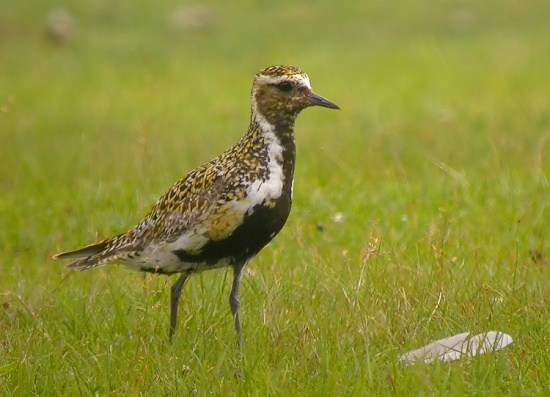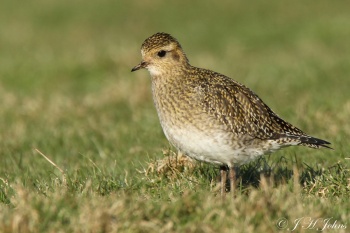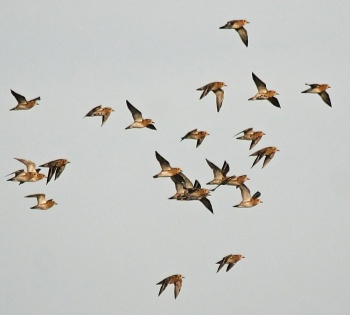(→External Links: GSearch amended) |
(Extra pictures, Behaviour expanded. References updated) |
||
| Line 1: | Line 1: | ||
'''Alternative name: Eurasian Golden-Plover''' | '''Alternative name: Eurasian Golden-Plover''' | ||
| − | [[Image:Eurasian_or_European_Golden_Plover.jpg|thumb|550px|right|Photo by {{user|Digiscoper321|Digiscoper321}}<br />West Sweden]] | + | [[Image:Eurasian_or_European_Golden_Plover.jpg|thumb|550px|right|Photo by {{user|Digiscoper321|Digiscoper321}}<br />West [[Sweden]], July 2005]] |
;[[:Category:Pluvialis|Pluvialis]] apricaria | ;[[:Category:Pluvialis|Pluvialis]] apricaria | ||
==Identification== | ==Identification== | ||
| Line 10: | Line 10: | ||
'''All plumages''' have short bill, bright golden coloured back, and white underwing coverts.<br /> | '''All plumages''' have short bill, bright golden coloured back, and white underwing coverts.<br /> | ||
===Similar Species=== | ===Similar Species=== | ||
| + | [[Image:Golden-plover-0103.jpg|thumb|350px|right|Non-breeding plumage<br />Photo by {{user|john-henry|john-henry}}<br />Camborne, [[Cornwall]], December 2010]] | ||
Overall much more golden coloured than other [[:Category:Pluvialis|Golden-Plovers]]. | Overall much more golden coloured than other [[:Category:Pluvialis|Golden-Plovers]]. | ||
[[American Golden Plover]] in all plumages have longer bill, longer primary projection, darker golden coloured back, white contrasting supercilium, and grey underwing; in breeding plumage has totally black undertail coverts and belly; in nonbreeding and juvenile plumages has grey weakly barred belly and grey back with dark golden spots.<br /> | [[American Golden Plover]] in all plumages have longer bill, longer primary projection, darker golden coloured back, white contrasting supercilium, and grey underwing; in breeding plumage has totally black undertail coverts and belly; in nonbreeding and juvenile plumages has grey weakly barred belly and grey back with dark golden spots.<br /> | ||
| Line 15: | Line 16: | ||
[[Grey Plover]] is slightly larger with white undertail, black and white spotted back, and white tail and rump. | [[Grey Plover]] is slightly larger with white undertail, black and white spotted back, and white tail and rump. | ||
==Distribution== | ==Distribution== | ||
| − | Northern [[Europe]] and western [[Asia]]. | + | [[Image:MG 0241 1-bf.jpg|thumb|350px|right|Non-breeding<br />Photo by {{user|Mahsleb|Mahsleb}}<br />Southwold, [[Suffolk]], February 2012]] |
| + | Northern [[Europe]] and western [[Asia]].<br /> | ||
| + | '''Europe''': [[Iceland]], [[Scandinavia]], [[Norway]], [[Sweden]], [[Finland]], [[Denmark]], [[Faroe Islands]], [[Greenland]], [[British Isles]], [[The Netherlands]], [[Belgium]], [[Luxembourg]], [[France]], [[Portugal]], [[Spain]], [[Ibiza]], [[Mallorca]], [[Canary Islands]], [[Extremadura]], [[Switzerland]], [[Liechtenstein]], [[Germany]], [[Austria]], [[Italy]], [[Sardinia]], [[Estonia]], [[Latvia]], [[Lithuania]], [[Belarus]], [[Poland]], [[Czech Republic]], [[Slovakia]], [[Hungary]], [[Slovenia]], [[Croatia]], , [[Montenegro]], [[Albania]], [[Macedonia]], [[Greece]], [[Corfu]], [[Lesvos]], [[Crete]], [[Malta]], [[Bulgaria]], [[Romania]], [[Ukraine]], [[Moldova]]<br /> | ||
| + | '''Northern Africa''': [[Morocco]], [[Algeria]], [[Libya]], [[Egypt]], cid.] | ||
| + | '''Western Africa''': [[Mauritania]], [[Liberia]], [[Nigeria]]<br /> | ||
| + | '''African Islands''': [[Gulf of Guinea Islands]], [[Sao Tome and Principe]]<BR /> | ||
| + | '''Middle East''': [[Turkey]], [[Cyprus]], [[Syria]], [[Lebanon]], [[Israel]]<br /> | ||
| + | '''Arabian Peninsula''': [[Iran]], [[Azerbaijan]], [[Georgia]]<br /> | ||
| + | '''Asia''': [[Russia]], [[Siberia]], [[Turkestan]], [[Kazakhstan]], [[Turkmenistan]], [[Pakistan]], [[India]], Western [[Himalayas]]<br /> | ||
| + | [[South Australia]] | ||
| + | [[Image:Aagolden.jpg|thumb|350px|right|Photo by {{user|cheersm8|cheersm8}}<br />[[Cambridgeshire]], [[UK]], September 2010 ]] | ||
==Taxonomy== | ==Taxonomy== | ||
| − | ====Subspecies<sup>[[#References|[1]]]</sup> | + | ====Subspecies==== |
| − | + | There are 2 subspecies<sup>[[#References|[1]]]</sup>: | |
*''P. a. altifrons'': | *''P. a. altifrons'': | ||
:*East-central [[Greenland]], [[Iceland]] and [[Faeroes]] to Taymyr Peninsula | :*East-central [[Greenland]], [[Iceland]] and [[Faeroes]] to Taymyr Peninsula | ||
*''P. a. apricaria'': | *''P. a. apricaria'': | ||
:*[[British Isles]] to [[Baltic States|Baltic]] Peninsula; winters [[Mediterranean]] and Persian Gulf | :*[[British Isles]] to [[Baltic States|Baltic]] Peninsula; winters [[Mediterranean]] and Persian Gulf | ||
| + | |||
| + | An additional subspecies ''oreophilos'' is generally considered to be invalid<sup>[[#References|[2]]]</sup>. | ||
==Habitat== | ==Habitat== | ||
| − | + | Breeds on moors and tundra, winters around coastal estuaries. | |
==Behaviour== | ==Behaviour== | ||
| + | ====Diet==== | ||
The diet includes insects, crustaceans, and berries. | The diet includes insects, crustaceans, and berries. | ||
| + | ====Breeding==== | ||
| + | Ground nesters. The nest is usually just a hollow in the open ground, relying on the egg colouration for camouflage. The clutch consists of 4 eggs, which vary from stone-coloured through buff to pale olive; they are well marked with reddish-brown or black streaks, spots and splotches. | ||
====Vocalisation==== | ====Vocalisation==== | ||
<flashmp3>Pluvialis apricaria (song).mp3</flashmp3><br /> | <flashmp3>Pluvialis apricaria (song).mp3</flashmp3><br /> | ||
''[[Media:Pluvialis apricaria (song).mp3|Listen in an external program]]'' | ''[[Media:Pluvialis apricaria (song).mp3|Listen in an external program]]'' | ||
==References== | ==References== | ||
| − | #{{Ref- | + | #{{Ref-Clements6thOct12}}#Wikipedia |
| + | #The Observer's Book of Birds' Eggs ISBN 0723200602 | ||
{{ref}} | {{ref}} | ||
==External Links== | ==External Links== | ||
| Line 37: | Line 54: | ||
<br /> | <br /> | ||
{{Video|European_Golden_Plover}} | {{Video|European_Golden_Plover}} | ||
| + | |||
[[Category:Birds]] [[Category:Pluvialis]] | [[Category:Birds]] [[Category:Pluvialis]] | ||
Revision as of 00:09, 13 April 2013
Alternative name: Eurasian Golden-Plover
- Pluvialis apricaria
Identification
10.5"
Breeding adult is stocky with golden back and cap; black face and belly with white supercilium which goes down neck along flanks; white undertail coverts.
Nonbreeding adult has buffy supercilium, buffy unmarked throat, and golden spotted breastband.
Juvenile has well-defined breast barring.
All plumages have short bill, bright golden coloured back, and white underwing coverts.
Similar Species
Overall much more golden coloured than other Golden-Plovers.
American Golden Plover in all plumages have longer bill, longer primary projection, darker golden coloured back, white contrasting supercilium, and grey underwing; in breeding plumage has totally black undertail coverts and belly; in nonbreeding and juvenile plumages has grey weakly barred belly and grey back with dark golden spots.
Pacific Golden Plover in all plumages have longer bill, darker golden coloured back, white contrasting supercilium, slightly longer legs, and grey underwing; in breeding plumage has white on flanks with black barring; nonbreeding plumage has greyish not as defined breast markings, whitish supercilium; juvenile has yellowish wash to face, barred yellowish breast and belly markings.
Grey Plover is slightly larger with white undertail, black and white spotted back, and white tail and rump.
Distribution
Northern Europe and western Asia.
Europe: Iceland, Scandinavia, Norway, Sweden, Finland, Denmark, Faroe Islands, Greenland, British Isles, The Netherlands, Belgium, Luxembourg, France, Portugal, Spain, Ibiza, Mallorca, Canary Islands, Extremadura, Switzerland, Liechtenstein, Germany, Austria, Italy, Sardinia, Estonia, Latvia, Lithuania, Belarus, Poland, Czech Republic, Slovakia, Hungary, Slovenia, Croatia, , Montenegro, Albania, Macedonia, Greece, Corfu, Lesvos, Crete, Malta, Bulgaria, Romania, Ukraine, Moldova
Northern Africa: Morocco, Algeria, Libya, Egypt, cid.]
Western Africa: Mauritania, Liberia, Nigeria
African Islands: Gulf of Guinea Islands, Sao Tome and Principe
Middle East: Turkey, Cyprus, Syria, Lebanon, Israel
Arabian Peninsula: Iran, Azerbaijan, Georgia
Asia: Russia, Siberia, Turkestan, Kazakhstan, Turkmenistan, Pakistan, India, Western Himalayas
South Australia
Taxonomy
Subspecies
There are 2 subspecies[1]:
- P. a. altifrons:
- P. a. apricaria:
- British Isles to Baltic Peninsula; winters Mediterranean and Persian Gulf
An additional subspecies oreophilos is generally considered to be invalid[2].
Habitat
Breeds on moors and tundra, winters around coastal estuaries.
Behaviour
Diet
The diet includes insects, crustaceans, and berries.
Breeding
Ground nesters. The nest is usually just a hollow in the open ground, relying on the egg colouration for camouflage. The clutch consists of 4 eggs, which vary from stone-coloured through buff to pale olive; they are well marked with reddish-brown or black streaks, spots and splotches.
Vocalisation
<flashmp3>Pluvialis apricaria (song).mp3</flashmp3>
Listen in an external program
References
- Clements, J. F., T. S. Schulenberg, M. J. Iliff, B.L. Sullivan, C. L. Wood, and D. Roberson. 2012. The eBird/Clements Checklist of Birds of the World. 6th ed., with updates to October 2012. Ithaca: Cornell Univ. Press. ISBN 978-0801445019. Spreadsheet available at http://www.birds.cornell.edu/clementschecklist/downloadable-clements-checklist
- Wikipedia
- The Observer's Book of Birds' Eggs ISBN 0723200602
Recommended Citation
- BirdForum Opus contributors. (2024) European Golden Plover. In: BirdForum, the forum for wild birds and birding. Retrieved 7 May 2024 from https://www.birdforum.net/opus/European_Golden_Plover
External Links







